Boat Pose Can Fire Up Your Core Muscles If You Do It Right—Here’s How
“At the heart of it, boat pose is a seated balance,” says Wendy Cope, a yoga instructor with Crunch Fitness. “And it's designed to strengthen the core. But just because it looks simple doesn't mean it is.”
If you’re looking for a new way to engage your midsection—and give yourself a fun balance challenge while you’re at it—boat pose could be just what your yoga practice is calling for.
- 01Instructions
- 02Muscles Worked
- 03Benefits
- 04Variations
- 05Common Mistakes
- 06Safety Precautions
- 07FAQ
- Rachel Hirsch, RYT, yoga teacher and founder of Empowered Yoga
- Wendy Cope, yoga instructor with Crunch Fitness
How to do boat pose with perfect form
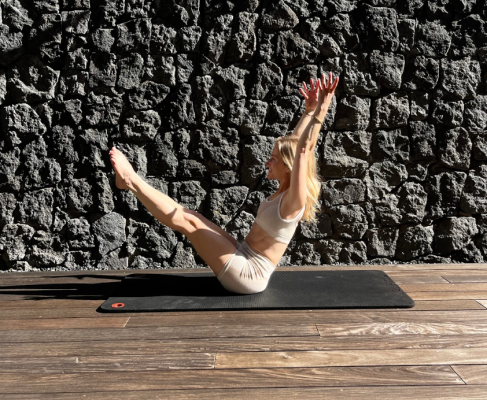
- Start by sitting down on your glutes with your knees bent and feet flat on the floor.
- Take your hands behind your hamstrings, lean back with your shoulders down and head reaching up, and draw your belly button into your spine.
- Lift one foot off of the ground, then the other, hands still behind your hamstrings. Keep your legs bent so your shins are parallel to the ground.
- If that feels good, take one hand off at a time and reach them both straight forward.
- To make it more intense, reach the hands up overhead.
- From there, you can extend your legs long so your entire body is making the shape of a letter V.
“There's no ‘right’ way to do it, as long as you're feeling the core engagement and thinking about the alignment of you're shoulders, hips, and head.” —Wendy Cope, yoga instructor
Which muscles are you working?
This major core challenge hits multiple muscles in your middle: your rectus abdominis (aka the six-pack muscles), transverse abdominis deeper in the core, obliques on the sides of your trunk, hip flexors, inner thighs, and even your lower back.

{{post.sponsorText}}
The benefits of boat pose that’ll convince you to give it a try
1. It boosts your core strength
Practicing boat pose can build major strength in your core. “And the more powerful your core is, the less work the rest of your body has to do,” Cope says, adding that a strong core can help protect your joints from injury.
2. It wakes up your hip flexors
Along with your core, boat pose also works your hip flexors, which often grow weak from sitting, according to Rachel Hirsch, RYT, founder of Empowered Yoga. “People often forget that in day-to-day life, we don't use our hip flexors a lot,” she says. Many cases of hip pain can be linked to weakness in these muscles, which we use to lift our thighs toward our trunk, she says.
3. It builds coordination
Because so many muscle groups are involved, boat pose can challenge your coordination. “The whole body is engaged, everything is lengthening, different muscle groups are working together to get you to balance, to fight the gravity,” Hirsch says.
4. It feels awesome to nail
Successfully doing any version of this pose can also give you a great sense of accomplishment because it’s so hard, Cope points out. “When you think about it, it's pretty cool that the body can bring itself into a V, fight gravity, and then stay there,” Hirsch says.
Variations to make boat pose more accessible
In nearly any yoga class, you’ll likely see students taking several different versions of boat pose. “There's no ‘right’ way to do it, as long as you're feeling the core engagement and thinking about the alignment of you're shoulders, hips, and head,” Cope says.
1. Forearms down and knees bent
Hirsch likes to get into boat pose with extra support from her arms.
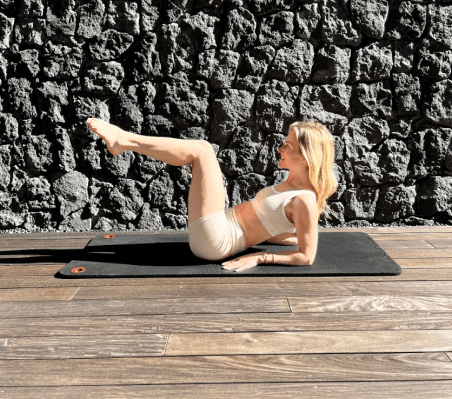
- Start by sitting down on your glutes with your knees bent and feet flat on the floor.
- Bring your forearms behind you and stack your shoulders on top of your elbows.
- From there, press your forearms into the ground to open up your chest and roll your shoulders back. before drawing your knees into a tabletop position.
- Lift one foot off of the ground, then the other, keeping your legs bent so your shins are parallel to the ground.
2. Forearms down and legs straight
From the previous position, if you’re feeling comfortable, you can try straightening the legs to create a V-shape with the body and increase the challenge.
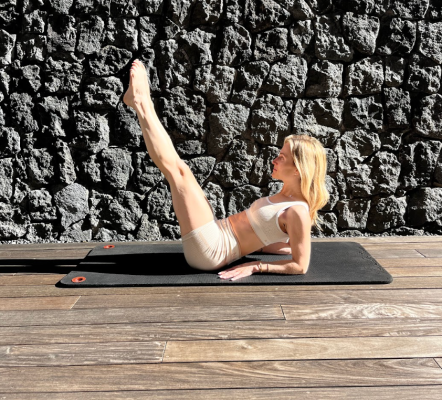
- Start by sitting down on your glutes with your knees bent and feet flat on the floor.
- Bring your forearms behind you and stack your shoulders on top of your elbows.
- From there, press your forearms into the ground to open up your chest and roll your shoulders back. before drawing your knees into a tabletop position.
- Lift one foot off of the ground, then the other, keeping your legs bent so your shins are parallel to the ground.
- Extend your legs long.
3. Knees bent
For this variation, follow the instructions for the full boat pose, but keep the knees bent in a tabletop position rather than extending them long. “I've been doing yoga for 20 years now, and I still keep my knees in tabletop,” says Hirsch. “You have to do what feels good.”
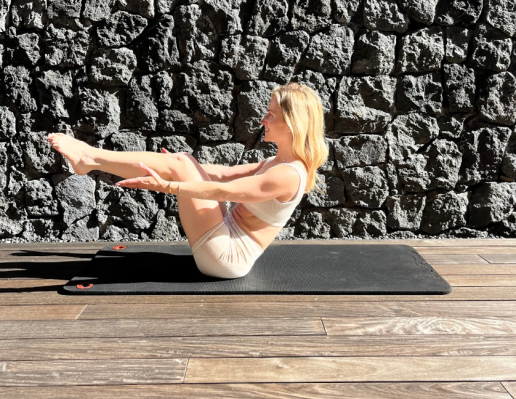
- Start by sitting down on your glutes with your knees bent and feet flat on the floor.
- Take your hands behind your hamstrings, lean back with your shoulders down and head reaching up, and draw your belly button into your spine.
- Lift one foot off of the ground, then the other, hands still behind your hamstrings. Keep your legs bent so your shins are parallel to the ground.
- If that feels good, take one hand off at a time and reach them both straight forward.
4. One leg straight
To test your balance and strength, you can do a knees-bent boat pose, then straighten one leg at a time. “Using one hip flexor at a time will probably keep the rest of your body in correct posture versus suddenly lifting both legs,” Hirsch says.
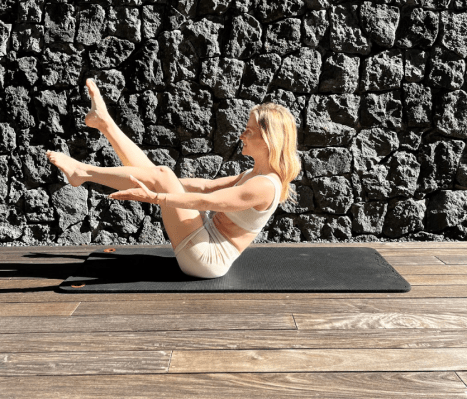
- Start by sitting down on your glutes with your knees bent and feet flat on the floor.
- Take your hands behind your hamstrings, lean back with your shoulders down and head reaching up, and draw your belly button into your spine.
- Lift one foot off of the ground, then the other, hands still behind your hamstrings. Keep your legs bent so your shins are parallel to the ground.
- If that feels good, take one hand off at a time and reach them both straight forward.
- Straighten your right leg and hold for a few breaths.
- Bend your right leg and straighten your left leg. Hold for a few breaths.
“When you think about it, it's pretty cool that the body can bring itself into a V, fight gravity, and then stay there.” —Rachel Hirsch, RYT
Common form mistakes—and how to avoid them
With a yoga pose this tricky, there are a number of technique cues to keep in mind. Avoid these mistakes.
1. Leaning too far back
A lot of people rock back onto their tailbones in boat pose and curve their lower back, but Cope says you actually want to stay further forward on your sit bones, which is harder.
“A lot of people are like, ‘Oh, I've got this all day,’ and really, that's [because they’re on the] more stable part of the pelvis,” she says.
2. Raising your shoulders
If you lift the hands overhead, it’s easy to let the shoulders follow suit, but Cope reminds students to keep them down.
“Keep pulling your shoulder blades back,” she says. If that’s too hard to do, Hirsch recommends bringing the arms down.
3. Craning your neck
Keep the entire back of the body straight—particularly through the neck. “A lot of time people put their neck out,” Cope says, adding that could dangerously impinge your cervical spine.
4. Splaying your ribs
As you find your balance, there’s sometimes a temptation to splay the ribs and arch your back, but this won’t properly engage your core.
“Really draw the navel up and in toward the rib cage,” Cope says. “Imagine that you've got a pair of tight jeans that you're trying to zip up right there.”
5. Letting your legs drift apart
Don’t forget to engage your inner thighs: Drawing them together will help you find your balance and engage your core, according to Cope.
6. Holding your breath
Last but not least, don’t forget to breathe! “That’s one thing people need to be reminded of,” Cope says.
Safety precautions to keep in mind
If you’re pregnant, you’ll probably want to skip this move, particularly in the second and third trimesters. And if you regularly have low back issues, Hirsch recommends keeping the forearms on the ground behind you to support your weight and allow you to focus on proper alignment.
“If you're ever feeling any pain, that is an immediate [sign] to pull back,” Hirsch says.
FAQ
1. What is boat pose good for?
Practicing boat pose regularly—even with a partner!—can build a core that’s strong enough to support you in all kinds of activities, and will help improve your posture and alignment. “As people get older, they start to curve a little bit,” Hirsch says. “The reason that a strong core is important is it helps hold you up straight.”
Cope adds that building core strength this way also gives you better control in any other kinds of movements you do. “So you've got better coordination. You've got better balance,” she says.
2. Why is boat pose so difficult?
Boat pose can be one of the hardest poses you do in a yoga class because the balance challenge required pushes your core and your hip flexor strength to their max.
3. How long should you hold boat pose?
The length of your boat pose depends on the situation, Cope says.
“If it's part of a Vinyasa flow, then maybe it's two or three breaths,” she says. But if you’re specifically working to nail boat pose, or doing it as part of a Hatha yoga class, you might hold it for five to 10 breaths. “It's whatever you can hold while continuing to breathe and keep the alignment.”
Loading More Posts...